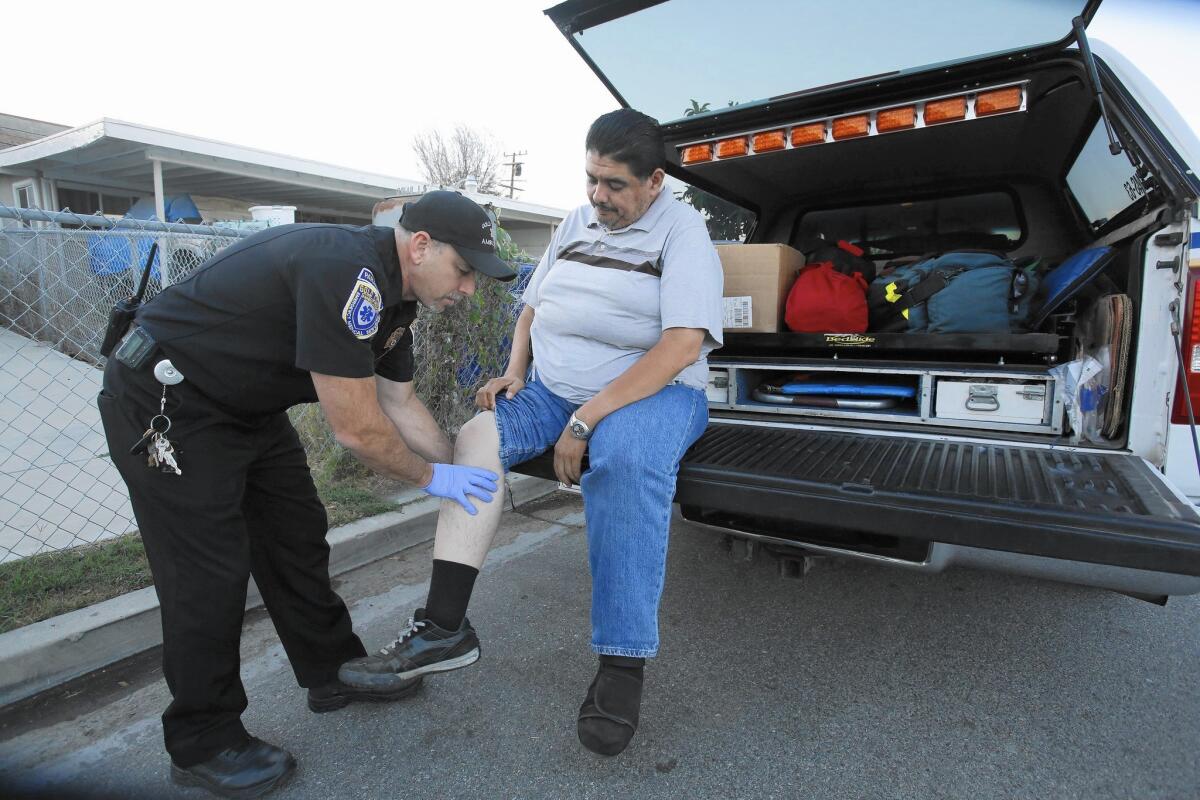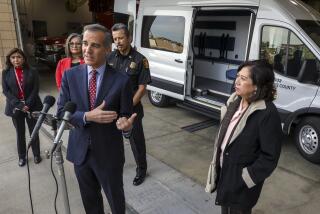New breed of paramedics treats patients before emergencies occur

- Share via
Paramedic Jacob Modglin parks on a palm-lined street in Oxnard and jumps out of his ambulance. He is prepared for any kind of emergency.
But his patient is standing in the driveway of a one-story house, holding a thermos, and smiling. It’s time for his 8 p.m. appointment.
Modglin is part of a new cadre of “community paramedics” working in a dozen pilot programs across California. Their jobs are to treat patients before they get sick enough to need emergency care.
The paramedics are still first responders, just deployed to prevent a crisis rather than react to one.
Many insurance companies and healthcare providers are seeking to curb spending by focusing on the small number of patients who drive the majority of costs. These so-called super-utilizers often have chronic conditions or other social problems that keep sending them to hospital emergency rooms and racking up big bills.
A patient who visits an emergency room unnecessarily or is repeatedly admitted to a hospital, for instance, could be suffering from a chronic medical condition, or may not be able to afford medicine, or may be too frail to go pick up fresh food — or all of the above.
That makes it difficult to know how to assist these patients. But California healthcare leaders hope these specially trained community paramedics can help.
“There’s a missing link in the chain here and we don’t know what that is, but we’re trying to find out,” said Dr. Steven Rottman, medical director of the UCLA Center for Prehospital Care, which trained the community paramedics.
In Ventura County, Modglin administers tuberculosis medicine to infected patients. Health officials there are worried about the illness — especially some cases that appear drug-resistant — and believe paramedics are in the best position to help stop its spread by providing patients with pills each day at their homes.
“I live in Ventura County, I have kids here, so it’s nice to know I’m helping prevent them from getting such a bad disease,” Modglin said.
NEWSLETTER: Get the day’s top headlines from Times Editor Davan Maharaj >>
Chatting under a fruit tree in the house’s frontyard, they also talk about the patient’s diabetes and the medicine that controls his high blood pressure. Modglin takes a look at the man’s knee, because he slipped and fell earlier in the day.
“Not only do I administer his TB medicine, but I’m here to make sure his overall health is good,” Modglin said.
Ventura County runs the tuberculosis program and another that sends paramedics to the homes of hospice patients.
Los Angeles County has two initiatives as well, gearing up next month. In one, community paramedics in Glendale will visit patients with congestive heart failure within three days of their discharge from the hospital. They will try to make sure those patients — who typically have high readmission rates — are following their doctors’ recommendations and living in an environment that’s conducive to recovery.
In 2017, researchers from UC San Francisco will evaluate the programs’ success.
Traditionally, paramedics are the first to arrive when someone calls 911. They are licensed by the state and can administer several medical treatments, such as CPR, first aid and intubations. Their quick decisions and care are often the difference between life and death.
California’s modern version of these emergency responders originated with a pilot program in Los Angeles County in the late 1960s as people started to take note of a high number of cardiac arrest deaths occurring outside hospitals. In 1970, California became the first state in the nation to allow paramedics to perform advanced medical life support.
But these days, Glendale paramedic Todd Tucker estimates that 10% to 20% of his calls aren’t medical emergencies.
“We get called for you-name-it,” said the Glendale fire captain, who’s part of both Los Angeles County pilot programs. A homeless man dials 911 when he’s cold and hungry, or an elderly woman calls each time she trips in her cluttered apartment.
He can provide immediate care and drive patients to an emergency room. However, he often can’t address their underlying issues.
“It’s frustrating for us to watch,” Tucker said. He thinks these new initiatives will allow paramedics to get people the attention they need.
Paramedics taking on this health coach role and visiting patients’ homes is cheaper than having it done by a registered nurse or physician, experts say. In California, the average annual wage for a paramedic is $35,720, while the average for a registered nurse is $98,400, according to the U.S. Bureau of Labor Statistics.
However, Janet Haebler, the American Nurses Assn.’s senior associate director of state government affairs, said there needs to be better regulations to make sure that paramedics going into a home are communicating with nurses and are integrated into the medical system.
“This is not a turf issue,” she said. “We’re talking about an old model that needs to shift.”
In another pilot initiative, community paramedics in Glendale and Santa Monica will be able to take 911 callers with less serious conditions to urgent care clinics instead of emergency rooms. The patients must meet certain criteria, such as experiencing isolated nausea or a fever, must be an adult and consent to go to a clinic.
About 60,000 calls annually in Los Angeles County could have been better served by such clinics, said Richard Tadeo, assistant director of Los Angeles County’s Emergency Medical Services Agency.
Dr. Jay Kaplan, president-elect of the American College of Emergency Physicians, said he is worried that giving paramedics the ability to determine where to take a patient goes too far.
He recalled a patient coming into the emergency department complaining of just a fever. After Kaplan asked a couple questions, the patient remembered that a few days earlier he had experienced intense indigestion and his arms went numb.
It turned out to be a heart attack.
“That probably saved his life,” said Kaplan, who practices in Marin County. “Had he presented to someone who was not knowledgeable and didn’t take the time to ask ... that patient could be dead.”
Other medical experts say paramedics have sufficient training to keep patients safe, and that they will follow strict regulations about where to take patients. There have been no major problems with similar programs across the country.
Although California law requires that paramedics take 911 callers only to emergency rooms, the state approved these pilot programs on a small scale so agencies could safely test out new methods of care, said Los Angeles County Emergency Medical Services Agency Director Cathy Chidester.
“The criteria that’s utilized is going to be very, very limiting, so we shouldn’t have a patient incorrectly sent to a clinic,” Chidester said. Plus, participating urgent care clinics will be prepared to rapidly transport a patient to the nearest emergency room, if they do end up having to go there, she added.
Supporters hope the programs will pave the way for a permanent group of community paramedics.
“We’re going to be like the hub of a wheel,” said Tucker, who has been a Glendale paramedic for 23 years.
As it is now, if he arrives at the house of an elderly woman who has fallen and he notices that her sink is overflowing with dirty dishes and ants, he can tell hospital workers, but can’t do anything himself. “We basically wipe our hands of that interaction.”
He wants to be able to call social services or a food delivery service himself, or get her a wheelchair ramp. He hopes paramedics can make the healthcare system work for people.
“We’re going to give them our number and tell them, ‘If you need something, give me a call.’ ”
soumya.karlamangla@latimes.com
Follow @skarlamangla for more California health news.
ALSO:
13,000 fall into homelessness every month, report says
Family of man killed by deputies releases witness’ video
Los Angeles County mental health director announces retirement
More to Read
Sign up for Essential California
The most important California stories and recommendations in your inbox every morning.
You may occasionally receive promotional content from the Los Angeles Times.














